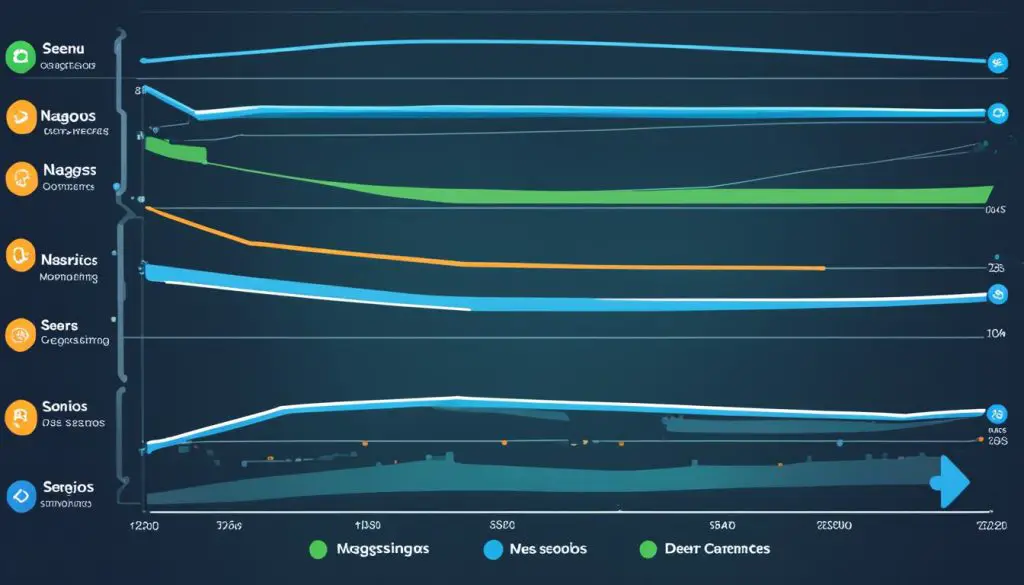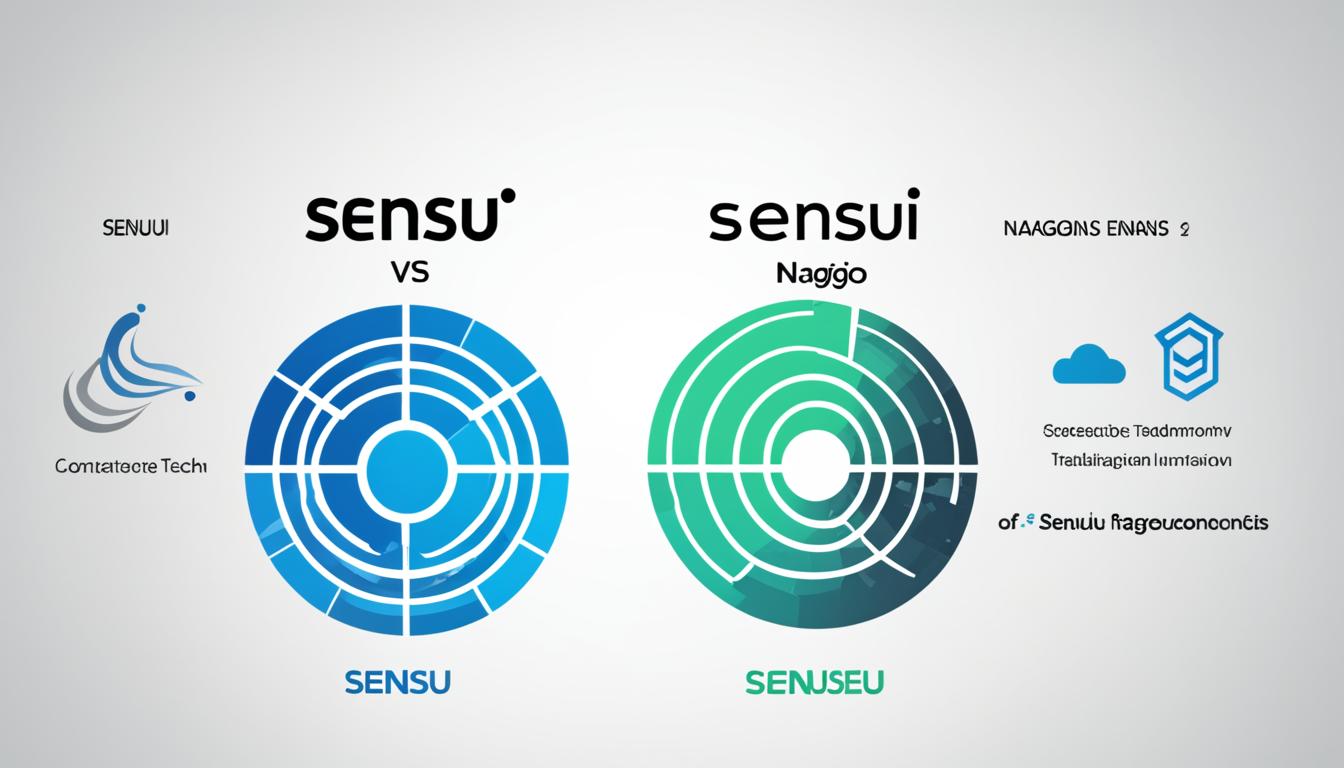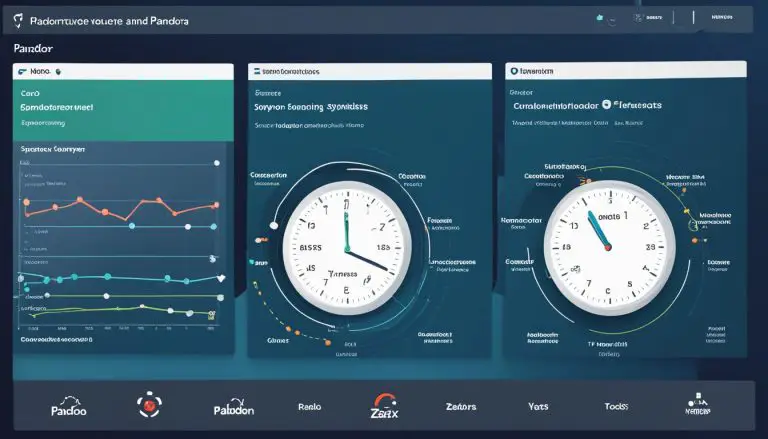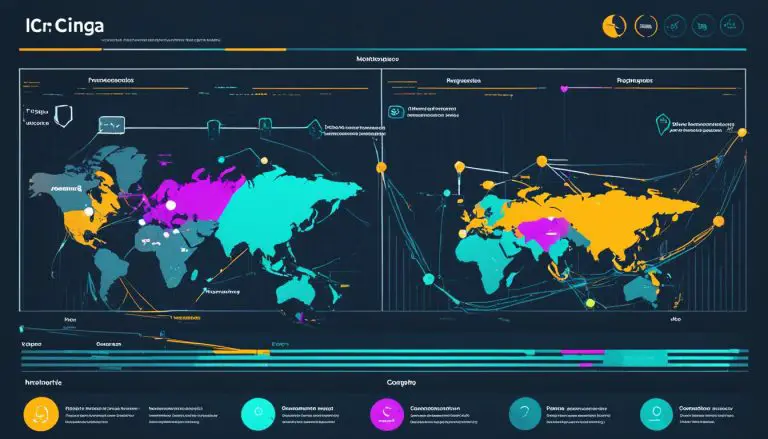Sensu vs. Nagios: An In-Depth Comparison Guide
When it comes to IT, network, and server monitoring, Sensu and Nagios have established themselves as prominent players in the field. But which tool is truly superior? Does Sensu’s advanced features outshine Nagios’ reliability? Or does Nagios’ reputation as a stalwart in the industry prevail over Sensu’s innovations?
In this comprehensive comparison guide, we delve deep into the similarities and differences between Sensu and Nagios, shedding light on their performance, features, and suitability for IT monitoring, network monitoring, and server monitoring. By the end, you’ll have the insights needed to make an informed decision that aligns with your business needs.
Key Takeaways:
- Discover the key differences between Sensu and Nagios in terms of performance, features, and target audience.
- Understand the platforms supported by both tools and their significance in your monitoring requirements.
- Explore the support options provided by Sensu and Nagios to ensure seamless usage and problem resolution.
- Learn about the APIs offered by each tool and how they contribute to integrations with other systems.
- Get an overview of the pricing models for Sensu and Nagios, including free versions and trials.
Platforms Supported
Sensu and Nagios are both robust monitoring tools that offer support for various platforms. Whether you’re running your infrastructure on Windows, utilizing SaaS/Web applications, or rely on on-premises solutions, both Sensu and Nagios have you covered.
Furthermore, if you’re constantly on the move, you can also monitor your systems from your iPhone, Android device, or even a Chromebook. The flexibility provided by Sensu and Nagios ensures that you can keep a close eye on your IT, network, and server environments, regardless of the platforms you use.
By offering comprehensive platform support, Sensu and Nagios empower businesses to monitor their entire technology stack, ensuring the smooth operation of critical systems and applications.
Sensu vs Nagios Platforms Supported:
- Windows
- SaaS/Web
- On-Premises
- iPhone
- Android
- Chromebook
Having the ability to monitor a wide range of platforms makes Sensu and Nagios versatile tools that can adapt to the specific requirements of your organization. Whether you operate in a hybrid cloud environment, have a mobile workforce, or manage a diverse technology landscape, these monitoring solutions ensure that you have full visibility into your systems, no matter where or how they are deployed.
By offering cross-platform support, Sensu and Nagios demonstrate their commitment to providing monitoring solutions that can seamlessly integrate into any IT infrastructure.
Target Audience
Sensu and Nagios are widely used monitoring tools, but they cater to different target audiences. Sensu is primarily aimed at developers, engineers, and other IT professionals who require deep visibility into various aspects of their infrastructure. Whether it’s monitoring servers, containers, services, applications, functions, or connected devices, Sensu offers a comprehensive solution that caters to the diverse needs of IT professionals working in any public or private cloud environment.
Sensu provides a robust monitoring platform that offers flexibility and scalability, making it an attractive choice for organizations with complex IT infrastructures. With Sensu, IT professionals gain the ability to monitor and track key metrics, set alerts, and gain insights into the health and performance of their systems and applications. The platform’s extensibility allows for seamless integration with a wide range of tools and technologies, enhancing its value for developers and engineers.
On the other hand, Nagios is predominantly targeted at network and systems administrators. As a powerful monitoring tool, Nagios focuses on providing network monitoring capabilities, allowing administrators to proactively monitor network resources, detect issues, and ensure optimal network performance.
While both Sensu and Nagios have distinct target audiences, it’s important to note that their functionalities and capabilities may overlap in certain areas. Organizations must carefully evaluate their specific needs and consider factors such as the complexity of their infrastructure, the level of customization required, and the type of monitoring they need to perform before deciding which tool aligns best with their requirements.
Support
When it comes to support, both Sensu and Nagios have you covered. They understand the importance of prompt assistance and provide various channels to address your concerns.
Firstly, you can reach out to their support teams via phone. Whether you prefer talking to someone directly or need immediate assistance, this option ensures you have direct access to their experts.
Additionally, both Sensu and Nagios offer 24/7 live support. This means that no matter the time of day or night, you can rely on their teams to assist you in resolving any issues that may arise.
Furthermore, these tools provide online channels for support. Whether it’s through email, chat, or a community forum, you can connect with others who have faced similar challenges and seek guidance or share experiences.
With their comprehensive support options, Sensu and Nagios ensure that you can get the assistance you need to optimize your monitoring processes and keep your systems running smoothly.
API
Both Sensu and Nagios provide APIs, offering seamless integration with various systems and tools. The APIs play a crucial role in streamlining and automating monitoring workflows, making it easier to fetch and process data for analysis and visualization.
With Sensu’s API, users can effortlessly access and manipulate monitoring data, including metrics, health checks, and event data. The Sensu API allows for easy integration with existing monitoring and alerting systems, as well as tools for reporting and analysis.
Similarly, Nagios also offers a robust API that enables users to interact with monitoring data and manage configurations programmatically. The Nagios API supports various operations, such as retrieving host and service statuses, acknowledging alerts, and performing configuration changes.
By leveraging the APIs of Sensu and Nagios, organizations can extend the functionality of these monitoring tools and integrate them into their existing infrastructures. The APIs provide the flexibility and power needed to customize and automate monitoring processes, ultimately enhancing the efficiency and effectiveness of IT, network, and server monitoring.
Customize Your Monitoring Workflow
Utilizing the APIs of Sensu and Nagios, you can tailor your monitoring workflow to suit your specific requirements. You can integrate these tools with other systems and tools, such as incident management platforms, log analysis solutions, and ticketing systems, creating a seamless and synchronized monitoring ecosystem.
By combining Sensu or Nagios with other tools via their APIs, organizations can achieve a comprehensive monitoring solution that addresses their unique needs and enables proactive problem detection and resolution.
Whether you choose Sensu or Nagios, having an API-centric approach empowers you to build a monitoring infrastructure that aligns perfectly with your business objectives and monitoring strategy. With the flexibility and extensibility provided by their APIs, Sensu and Nagios ensure that you can adapt and scale your monitoring environment as your business grows and evolves.
Integrating with Third-Party Applications
Both Sensu and Nagios APIs open up opportunities for integration with a wide range of third-party applications. These can include popular IT service management (ITSM) tools, collaboration platforms, cloud management systems, and more. By seamlessly integrating these tools, organizations can centralize their monitoring and incident management processes, improving efficiency and collaboration across their entire IT ecosystem.
- Integrate Sensu or Nagios with ITSM tools like ServiceNow or Jira to create automated incident management workflows and improve response times.
- Combine Sensu or Nagios with collaboration platforms like Slack or Microsoft Teams to enable real-time notifications and facilitate communication among IT teams.
- Integrate Sensu or Nagios with cloud management systems like AWS CloudWatch or Google Cloud Monitoring to get a holistic view of your infrastructure, both on-premises and in the cloud.
The possibilities for integration are virtually endless, and the APIs provided by Sensu and Nagios make it easy to unlock the full potential of these tools by extending their capabilities and integrating them seamlessly into your existing ecosystem.
Automation and Orchestration
By leveraging the APIs of Sensu or Nagios, organizations can automate and orchestrate various monitoring tasks, allowing for more efficient and streamlined operations. This includes automating the deployment and configuration of monitoring checks, generating dynamic dashboards and reports, and triggering automated responses to critical incidents.
With the right automation and orchestration workflows in place, organizations can minimize manual intervention, reduce human errors, and ensure consistent monitoring practices across their infrastructure. This ultimately leads to improved reliability, faster incident resolution times, and a more proactive approach to maintaining the health and performance of IT systems, networks, and servers.
Pricing
When it comes to choosing the right IT monitoring tool, pricing is an important consideration. Sensu and Nagios offer different pricing models to suit various business needs.
Sensu Pricing
Sensu’s pricing starts at $600.00/month. This subscription-based model provides access to their feature-rich monitoring platform, ongoing updates, and technical support. Sensu also offers a free version and trial to allow users to experience the platform’s capabilities before making a commitment.
Nagios Pricing
Nagios, on the other hand, uses a one-time payment pricing structure. Their pricing starts at $1995.00/one-time, which grants you a perpetual license for their monitoring solution. Like Sensu, Nagios also offers free versions and trials to help you evaluate the tool’s compatibility with your requirements.
Ultimately, the choice between Sensu and Nagios pricing depends on your budget and preference. Sensu’s subscription model may provide flexibility for businesses seeking regular updates and continuous support, while Nagios’ one-time payment option appeals to those looking for a long-term investment. Both tools offer free versions and trials, allowing you to explore their capabilities and decide which one best aligns with your organization’s needs.
Reviews and Ratings
Sensu and Nagios are two leading tools in the field of IT, network, and server monitoring.
While these tools have gained popularity among businesses, there are currently no reviews or ratings available to provide insight into their performance.
However, we encourage you to be the first to share your experience and provide a review of Sensu or Nagios.
Your feedback can help other professionals make informed decisions when choosing a monitoring tool for their specific needs.

The Importance of Reviews and Ratings
Reviews and ratings play a crucial role in helping potential users gain confidence in a product or service. They offer valuable insights into the pros and cons, user experience, and overall satisfaction levels. By sharing your experience with Sensu or Nagios, you can contribute to creating a comprehensive resource for others in the monitoring community.
Leaving a review allows you to highlight the aspects that impressed you the most, such as performance, features, usability, and customer support. Additionally, it provides an opportunity to share any challenges you encountered while using the tool.
Whether you have positive or constructive feedback, your review can help others make informed decisions, save time, and avoid potential pitfalls. Furthermore, your evaluation can contribute to the ongoing development and improvement of Sensu and Nagios.
Click the link below to write a review for Sensu or Nagios:
Training
When it comes to training options, both Sensu and Nagios offer a range of resources to help you get started and maximize your understanding of their platforms. Whether you prefer self-paced learning or interactive sessions, Sensu and Nagios have you covered.
Sensu provides detailed documentation that serves as a comprehensive guide to their tool’s features, functionalities, and best practices. This resource is ideal for those who prefer self-guided learning and want to explore the platform at their own pace.
In addition to documentation, Sensu offers webinars that provide a more interactive learning experience. These webinars cover a variety of topics related to Sensu, allowing you to delve deeper into specific areas of interest or enhance your overall understanding of the tool.
For those who prefer real-time interaction, Sensu also offers live online sessions where you can join instructors for in-depth discussions and demonstrations. These sessions provide an opportunity to ask questions, receive personalized guidance, and gain practical insights into using Sensu for IT, network, and server monitoring.
If you prefer a more hands-on approach, Sensu even provides in-person training sessions where you can learn directly from experienced instructors. These training sessions offer a comprehensive learning experience, combining theoretical knowledge with practical examples and exercises.
Nagios, on the other hand, offers a similar range of training options. Their documentation is a valuable resource for self-guided learning, providing detailed instructions and explanations of Nagios’ features and functionalities.
In addition to documentation, Nagios offers webinars and live online sessions, allowing you to interact with instructors and learn from their expertise. These sessions cover a wide range of topics, from basic configuration to advanced troubleshooting techniques.
Both Sensu and Nagios understand the importance of training in helping users maximize the potential of their tools. Whether you prefer self-paced learning, interactive webinars, live online sessions, or in-person training, both Sensu and Nagios have options available to suit your preferred learning style and schedule.
Key Takeaways:
- Sensu offers documentation, webinars, live online sessions, and in-person training for learning their monitoring tool in-depth.
- Nagios provides extensive documentation, webinars, and live online sessions to help users learn and make the most of their monitoring platform.
- Both Sensu and Nagios understand the importance of training options to cater to different learning styles and preferences.
Company Information
When considering the choice between Sensu and Nagios for your IT, network, and server monitoring needs, it’s important to take into account their respective company information.
Sensu was founded in 2017 in the United States. As a relatively new player in the monitoring space, Sensu has quickly gained recognition for its innovative approach to monitoring infrastructure and applications. With a focus on providing deep visibility into servers, containers, services, applications, functions, and connected devices across any public or private cloud, Sensu caters to the needs of developers, engineers, and other IT professionals.
Nagios Enterprises, on the other hand, has a longer history having been founded in 2007, also in the United States. With over a decade of experience, Nagios has established itself as a trusted name in network and systems monitoring. The company primarily targets network and systems administrators, offering a robust set of features to monitor and manage network infrastructure.
Understanding the background and history of each company can provide valuable insights into their respective strengths and areas of expertise. Stay tuned for the next section where we will explore the support options provided by Sensu and Nagios.
Conclusion
In conclusion, Sensu and Nagios are both powerful tools for IT, network, and server monitoring. Both offer a wide range of features, support, and integration options to meet the needs of businesses of all sizes. The choice between Sensu and Nagios ultimately depends on your specific business needs, preferences, and budget.
When making a decision, it is essential to evaluate the features offered by each tool. Consider the platforms supported, target audience, and API capabilities. Additionally, take into account the pricing structures of Sensu and Nagios, including any free versions or trials that may be available.
Remember to consider the support options offered by both tools, as reliable and responsive support is crucial when dealing with monitoring systems. Sensu and Nagios both offer support through various channels, including phone, 24/7 live support, and online resources.
Ultimately, to choose between Sensu and Nagios for your monitoring needs, it is essential to take the time to thoroughly evaluate each tool’s features, pricing, and support. By making an informed decision, you can ensure that your monitoring strategy aligns with your business objectives and provides the necessary visibility into your IT infrastructure.
FAQ
What are the key differences and similarities between Sensu and Nagios?
Are there any reviews available for Sensu and Nagios?
What support options are available for Sensu and Nagios?
Which platforms are supported by Sensu and Nagios?
How much do Sensu and Nagios cost?
- About the Author
- Latest Posts
Mark is a senior content editor at Text-Center.com and has more than 20 years of experience with linux and windows operating systems. He also writes for Biteno.com





